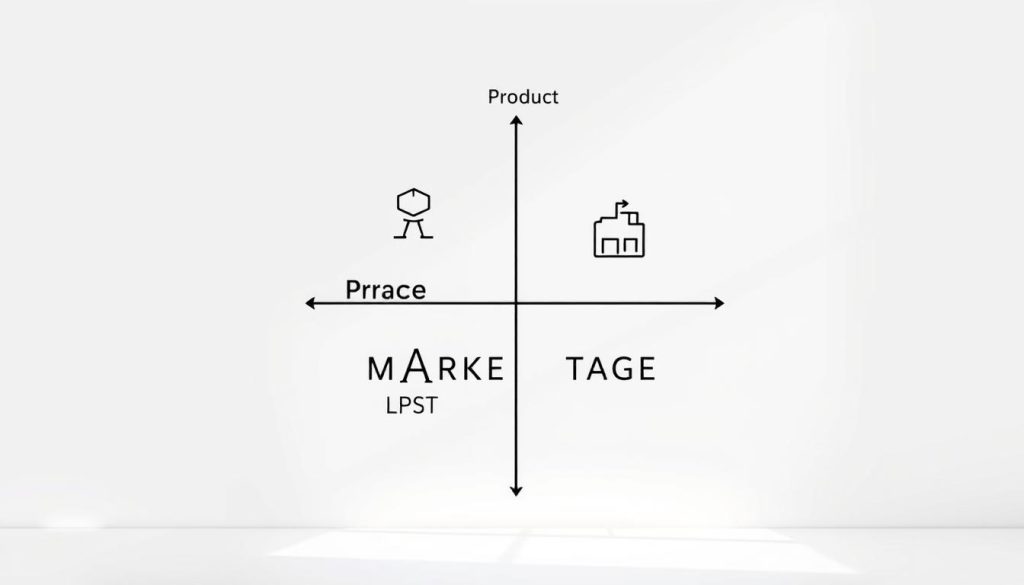When Claire left a Paris agency to work solo, she feared losing visibility. She set simple goals, mapped her audience, and tested a clear marketing strategy focused on her specialty. Within months, she had a steady pipeline of qualified customers and a calm routine for content and social media.
We share that same practical approach here. Our aim is to help you define a clear strategy that aligns your value proposition with a chosen market. You will learn how to set goals, pick media that matter, and keep your website and social channels working together.
This is not about chasing every trend. It is about building consistent brand presence and measurable progress. For an independent in France, a focused plan reduces risk and makes growth achievable with limited time.
Table of Contents
Key Takeaways
- Document a simple strategy to align your offer with the right audience.
- Prioritize channels that bring qualified customers and measurable results.
- Use your value proposition to guide pricing, content, and delivery.
- Start with low-risk actions, test, then scale what works.
- A consistent website and social media presence builds credibility and leads.
Why Marketing Strategy Matters Now for Independents in France
With mobile search and social apps dominant, an intentional approach helps independents convert interest into work. Digital habits mean your audience expects to discover services via search, social media, and a trustworthy website. Your actions should match where they spend time.
Context: digital habits and buyer behavior
Digital transformation is real: social networks, mobile browsing, and content influence how French clients decide. A documented plan lets you interpret market signals and pick the right media instead of spreading time and budget thin.
From visibility to measurable return
Brand awareness must become concrete outcomes: qualified customers, a fuller pipeline, and steady revenue. Track simple KPIs—site visits from your target audience, conversion rates, booked consultations, and cost per lead—to control and adapt investments.
- Start small: refine service pages and focus on one primary channel.
- Use a basic template to document audience, offer, channels, and KPIs.
- Keep researching competitors to spot gaps and differentiate your service.
| Objective | Early Indicator | Measurement | Action |
|---|---|---|---|
| Awareness | Website visits from target audience | Unique visits / week | Improve SEO on service pages |
| Acquisition | Booked consultations | Consults / month | Clear CTA and booking form |
| Efficiency | Cost per lead | € per lead | Focus spend on best-performing channel |
Confidence grows with simple tests. Even if many small businesses feel unsure, a short documented plan and fast research cycles let you learn what works and show return on investment in limited time.
Marketing Strategy vs. Marketing Plan: Know the Difference
A firm strategic frame stops tactics from becoming scattered efforts. It clarifies long-term position so daily work has purpose.
Long-term direction versus tactical roadmap
Strategy defines your long-term goals, target personas, value and channel choices. It sets the KPIs and the 4Ps/7Ps considerations that guide decisions.
Plan lists tactical actions: paid campaigns, influencer partnerships, timelines, and weekly tasks. The plan changes; the strategy stays stable.
- Simple process: define goals → research competitors and audience → choose media and content → schedule actions.
- Let strategic goals cascade into plan-level targets (example: position as go-to for SMEs → 20 leads/month).
- Keep the plan lightweight with weekly checkpoints and time-boxed experiments.
Practical tip: use a short template to record who does what and when. Link your website content calendar and social posts to the plan so execution stays consistent and on-brand.
| Aspect | Strategy | Plan |
|---|---|---|
| Purpose | Long-term positioning and goals | Tactical actions and timelines |
| Horizon | 6–24 months | Weekly to quarterly |
| Examples | Niche for SMEs; KPIs | Two campaigns and one partnership this quarter |
Set SMART Goals That Tie Marketing to Business Outcomes
Define targets that link each content piece and channel to a business result. SMART goals—specific, measurable, achievable, relevant, time-bound—help you decide where to spend limited time and money.
Make sure each goal has a metric, a clear deadline, and an owner. That makes reviews calm and objective, not personal.
Start with one primary target segment. Translate an annual objective (for example, more booked consultations) into quarterly and weekly goals for content, media, and outreach.
- Set leading indicators: traffic quality, email opens, content engagement.
- Set lagging indicators: sales, retention, revenue per customer.
- Document assumptions behind each goal so reviews become learning moments.
« Clear goals focus resources and make performance easy to judge. »
| Goal | Metric | Horizon | Owner |
|---|---|---|---|
| Increase qualified leads | Consultations / month | Quarterly | You |
| Improve content engagement | Avg. time on page | Monthly | You / Content partner |
| Boost newsletter conversions | Sign-ups → bookings rate | Quarterly | You |
Conduct Market Research to Understand Demand and Competitors
Begin by framing one clear question that your research will answer about the market.
Right-size the process. Define three core questions, gather quick data, and turn insights into one immediate test. Use analytics, trend reports, and small surveys to avoid overwork.
SWOT and market sizing for a solo business
Map strengths and gaps against real demand. Estimate reachable audience size and a realistic share to set goals and a sensible budget.
Qualitative methods
Run short interviews and 5–8 question surveys to capture customer language. Observe forums and competitor sites to find decision drivers and friction points.
Competitive analysis to position your offer
Create a concise grid: pricing, promises, proof. This clarifies where to emphasize value and how your plan should differ.
« Document findings in a simple template so assumptions can be tested and updated. »
| Step | What to do | Outcome |
|---|---|---|
| Define questions | 3 focused hypotheses | Clear testable goals |
| Collect data | Interviews, survey, analytics | Customer language and demand signals |
| Analyse rivals | Competitor grid (price, proof) | Positioning and immediate offer tweak |
Next steps: test one core message, refine one offer, and pick one acquisition channel to validate quickly.
Segment Your Audience and Build Buyer Personas
Clarifying who uses, buys, and recommends your service simplifies every content choice. This step turns broad goals into precise actions you can test and repeat.
Identify users, buyers, and prescribers for your services
Define three clear segments: the end user, the buyer who authorizes purchase, and any prescriber who recommends you.
For each segment capture demographics, goals, pain points, and decision criteria. Link those traits to specific messages and proof points that communicate value calmly and clearly.
Personalization at scale with lightweight tools
Use simple tools you already have—email tags, CRM fields, and modular website blocks—to tailor content by segment. Personalization at scale boosts results: research shows tailored experiences increase sales for most professionals.
- Prioritise one or two target segments where you can win quickly.
- Map which media and content each segment consumes and focus effort there.
- Document messaging boundaries to protect your brand tone while tailoring offers.
« Personalization at scale increases sales for 96% of marketers. »
Plan short reviews to update personas as the market shifts. Small, regular updates keep your marketing strategy relevant and grounded in real customer signals.
Craft a Clear Value Proposition and Positioning Statement
Clients choose clarity: a simple statement that names who you help, the pain you solve, and the benefit you deliver.
Define your value proposition in one sentence: who you serve, the problem you fix, and the outcome customers can expect.
Make your positioning explicit, different, and relevant. That helps customers decide quickly and reduces time spent explaining offers.
Different, relevant, and explicit messaging
Align with the local market and trends. State the service specifics and the quality level your clientele expects. Keep claims modest and verifiable.
Clarify proof. Use case examples, testimonials, or a short process outline to make communication credible and calm.
- Translate your proposition into measurable goals for content and offers.
- Pick one core differentiator—speed, expertise, design, or service—and show it consistently.
- Reference competitors to highlight fit for your chosen segment without attacking them.
« A strong position is explicit, different, and relevant—then you can test it with real customers. »
Example positioning line to test: « We help Paris-based SMEs reduce onboarding time by half with clear contracts and fast delivery. »
Choose Among Core Strategy Types
Picking the right strategic path simplifies choices and aligns daily work with clear goals.
Concentration (focus) for niche dominance
Concentration means serving a single segment deeply. For independents in France, this reduces wasted effort and builds reputation fast.
Focus resources where you have an enduring advantage—expertise, network, or a unique method. Measure progress by share in that niche, revenue per client, and referral rate.
Differentiation to stand out across segments
Differentiation aims to be distinct across several segments through quality, innovation, or service layers.
Use features or a premium process to defend margin. Track metrics like conversion by segment and average contract value to ensure the approach pays off.
Skimming vs. Penetration pricing: when each makes sense
Skimming launches with high prices aimed at early adopters, then lowers prices over the lifecycle. Penetration uses low prices to gain quick share and needs investment in distribution or promotion.
Example: an independent consultant might use skimming for a new premium audit, then offer lower-rate packages later. Alternatively, a penetration tactic fits when you want rapid client acquisition to build volume.
- Choose one primary approach to avoid mixed signals and protect your brand promise.
- Tie the approach to measurable goals—share, revenue, or acquisition speed.
- Adjust tactics if larger competitors enter or undercut pricing; emphasize demonstrable value at your price point.
Test small. Run short experiments to validate assumptions before committing time and budget.
Competitive analysis helps choose the right path and anticipate moves from larger players.
Build Your Marketing Mix: From 4 Ps to 7 Ps

Start by matching what you sell to what clients actually value, not what you imagine they want. This ensures product design and price reflect real expectations.
Product and Price aligned to perceived value
Package your offers as clear, named products so clients can compare outcomes. Show expected results, duration, and deliverables.
Price should mirror perceived value. Test one tiered package and one premium option to validate willingness to pay.
Place and Promotion: channels that meet your audience
Pick distribution and promotion where your customer looks first—concise website pages, targeted media, and selective partnerships.
Keep promotion focused: one owned channel, one earned tactic, and one small paid test per quarter.
People, Process, and Physical evidence for service-based pros
Document the service process and response times. Train touchpoints to deliver a consistent professional tone.
Collect visible proof—case summaries, short testimonials, and a clear process page on your website—to strengthen trust.
- Quarterly rule: plan one improvement per P so progress stays manageable.
- Document tone, visuals, and response standards to protect your brand.
- Link every change to goals: acquisition, satisfaction, or retention.
- Use a light plan marketing approach to track dependencies when one P affects others.
| Component | Action | Measure |
|---|---|---|
| Product | Create 2–3 clear packages with outcomes | Conversion rate on package page |
| Price | Tiered pricing and one premium option | Average revenue per customer |
| Place/Promotion | Focus on website page, one media, and referrals | Traffic from target channels |
| People/Process/Evidence | Document process; collect short proofs | Customer satisfaction and repeat rate |
« Align decisions across the mix so adjusting one element improves outcomes without creating new problems. »
Channel Strategy: Paid, Owned, and Earned Media
Select channels that match where your customers spend time and where you can publish consistently. A calm, focused mix keeps daily work sustainable and measurable.
Social media, website, email, and search
Group channels into paid (ads, SEM, sponsorships), owned (website, email, blog), and earned (UGC, PR). Own your website and newsletter as the centre of gravity; use paid and earned to extend reach.
Start organic. Build SEO fundamentals and a steady content calendar before allocating budget. That sequence makes paid spend more predictable and cost-effective.
- Pick one social network where your customers engage and match content cadence to your capacity.
- Document actions per channel: calendar, response rules, conversion paths, and simple analytics tags.
- Use analytics to attribute impact so each action links back to customer outcomes and your plan.
Example channel stack for an independent: website + newsletter + one social network, then add paid retargeting once basics show consistent performance.
« Serve existing customers first, then attract new ones efficiently. »
Define governance: posting frequency, brand tone, and reply time. Build feedback loops so channel signals inform offer tweaks and future budget decisions.
| Channel type | Primary role | Simple metric |
|---|---|---|
| Owned (website, email) | Conversion hub | Consults / month |
| Paid (ads, SEM) | Scale and reach | Cost / lead |
| Earned (UGC, PR) | Trust and proof | Referrals / mentions |
Content Marketing That Drives Engagement and Trust
Good content turns curiosity into trust by answering real questions simply.
Format choices should link directly to goals: teach with short guides, entertain with light case stories, and convert with clear how-to pages and CTAs.
Formats that educate, entertain, and convert
Define three content pillars that map to audience problems and your product outcomes. Balance practical advice with brief examples so readers see immediate value.
Use authentic visuals and selective partnerships when it serves credibility—brands like Caraway and The Honey Pot show how design or humor can extend reach without complex campaigns.
Editorial cadence, templates, and repurposing
Set a sustainable cadence: one long article or case summary per month and two shorter pieces for your website and social media.
Reduce friction with templates for briefs, outlines, and checklists. Repurpose top-performing pieces into emails, short videos, and social posts to save time and keep quality high.
Measure engagement—time on page, shares, and consult requests—and refine topics with light research so each item supports discoverability and trust.
« Helpful, consistent content turns prospects into informed clients. »
| Purpose | Format | Simple metric |
|---|---|---|
| Educate | How-to article, short guide | Avg. time on page |
| Entertain | Case story, short video | Social shares / comments |
| Convert | Case summary + CTA | Consults / month |
Budgeting for an Independent: Spend Smart, Prove ROI
Careful budgeting helps independents protect cash flow while proving what works. Many small firms allocate 7–10% of revenue to promotion, but as an independent you can start smaller and grow spend only after results validate your choices.
Start narrow, scale what works
Begin with one core channel and one conversion offer. Use a modest monthly budget for that channel and run a short test (4–8 weeks) to measure qualified leads and signed clients.
Make sure each cost line maps to a clear goal and metric—consultations booked, cost per lead, or conversion rate—so decisions stay objective.
- Use platform budgeting tools to estimate reach and costs before committing.
- Allocate time as part of the budget: content creation, follow-up, and measurement all require protected hours.
- Balance spend between acquisition and retention to stabilize revenue for your business.
Document actions and halt underperforming tactics quickly. Keep a small contingency to seize unexpected opportunities without jeopardizing cash flow.
| Budget item | Initial allocation | Goal | Success metric |
|---|---|---|---|
| Core channel ad or tool | €100–300 / month | Generate qualified leads | Cost per lead & consults / month |
| Content & time | Equivalent of 4–8 hours / week | Improve organic discoverability | Avg. time on page & leads from content |
| Retention & proof | €50–150 / month | Increase repeat bookings | Repeat rate & LTV |
« Scale budget only after validated performance; tie every euro to an outcome, not vanity metrics. »
KPIs and Performance Measurement to Optimize Your Actions

Pick three metrics that reveal whether your work turns into real client outcomes. Start with a focused set across the funnel so you can spot where to act. Keep reports short and regular: weekly for rapid fixes, monthly for trends.
From awareness to revenue: metrics that matter
Define KPIs for awareness, consideration, conversion, and retention. Examples: engaged sessions, consults per month, cost per acquisition, and repeat rate.
Link each KPI to a goal and a budget line so scaling or pausing a tactic is an objective choice, not an opinion.
Analytics stack and simple dashboards
Build a lean analytics stack that unifies website, media, and email data. Use one dashboard template with weekly and monthly panes to balance fast feedback with trend analysis.
- Track quality, not just volume (lead quality, sales cycle time).
- Run post-campaign reviews and document hypotheses for the next test.
- Compare visible competitor benchmarks to interpret results in context.
| Funnel | Core KPI | Action |
|---|---|---|
| Awareness | Engaged sessions | Improve content relevance |
| Conversion | Consults / month | Refine CTA and offer |
| Retention | Repeat rate | Adjust onboarding and value delivery |
Practical step: use a lightweight performance metrics template to start. Translate data into clear actions—tweak content, adjust targeting, or reallocate budget—to protect value and improve results.
Iterate: Control, Learn, and Adapt Your Marketing Strategy
Small, structured experiments show where your effort creates real client value. Start with clear, limited tests that measure process, distribution, satisfaction, and brand performance.
Run tests with a simple protocol. Make sure each experiment has a hypothesis, a timeline, and a defined success threshold. Document expected results and the next steps before you run the test.
Run tests, document insights, refine the plan
Review performance routinely. Use short, weekly check-ins for operational fixes and monthly reviews for pattern recognition. Link KPIs to decision rules so you act on evidence, not on hunches.
- Adopt a test-and-learn process with small experiments and clear success thresholds.
- Record each test in a shared log with examples so wins become repeatable and losses become lessons.
- Refine tactics—offers, content, and media mix—based on data and client feedback.
- Protect delivery quality while you test to keep existing clients satisfied.
- Use time-boxed sprints to maintain momentum without overextending your time.
Close the loop. When patterns hold across several tests, update your plan and strategy statements. This keeps your actions aligned with market signals and preserves the stability your clients expect.
« Test small, measure often, and change only when evidence points clearly to better outcomes. »
Marketing Strategies Examples for Independent Professionals
Concrete examples show how focused action wins attention without large budgets. Below we review three real-world approaches and translate each into practical tactics you can use as an independent in France.
Design-led positioning
Example: Caraway used strong product photography and real-life scenes to lift perceived quality and earn major press features.
Independent tactic: stage one service in client-like settings, capture simple case visuals, and publish a short gallery on your service page to raise trust and justify a higher fee.
Authentic partnerships
Example: The Honey Pot partnered with aligned creators and used humour to make a category approachable and shareable.
Independent tactic: collaborate with micro-influencers who reflect your values. Co-create short content and trade services or small fees to keep budget low.
Creative campaign focus
Example: Heyday ran a single creative pop-up and amplified it on TikTok, generating earned creator promotion and strong views.
Independent tactic: pick one bold local activation or workshop, spend a compact budget on promotion, then repurpose the content across social media and email.
| Approach | Independent-friendly tactic | Budget guidance | Success metric |
|---|---|---|---|
| Design-led positioning | Case gallery + staged visuals on service page | €0–200 for photo session | Page conversion rate |
| Authentic partnerships | Micro-influencer co-created posts | Product/service exchange or €50–300 | Engagement and consult requests |
| Creative campaign focus | Local pop-up or workshop + short video | €200–1,000 depending on scope | Social reach & earned media mentions |
Plan follow-up: define a clear success threshold before launch and a repurposing plan after. Turn earned content into case studies, emails, and short posts to extend value.
« Successful marketing comes from a clear strategy and steady execution, not only large spends. »
Marketing Strategies
Choose one clear path that matches your offer, your time, and the clients you can serve best. A documented strategy should list goals, value proposition, core research findings, target segments, messaging, and chosen channels.
Core approaches: concentration (focus), clear differentiation, and value-led pricing. Align each with a measurable target so you know what success looks like in weeks and months.
Simple template outline: goals; research highlights; target segments; productised service descriptions; channel selection; KPIs; timelines; owner; budget.
- Operational plan: convert strategy into a short plan with timelines, named owners, and budget lines.
- Minimal media stack: website, one social channel, one nurture (email/newsletter).
- Keep product pages explicit so prospects understand scope, outcomes, and time.
| Item | Example | Metric |
|---|---|---|
| Offer | Audit package (2 weeks) | Consults / month |
| Channel | Website + LinkedIn + Email | Leads / month |
| Budget | €150 / month | Cost per lead |
Research updates keep your plan current without overload. Finally, use brand standards to guide tone, visuals, and promises across every touchpoint.
Focus, test, and document — that sequence protects cash and grows reputation.
Conclusion
A focused next step turns planning into measurable progress in days, not months. Link clear goals to one simple action you can deliver this week.
Keep your strategy steady and let the plan handle daily actions. Finalize one goal, one audience segment, and one offer to promote on your website or primary page.
Make sure your positioning and brand standards show on every touchpoint so the customer sees consistent proof of value.
Commit to short, regular reviews and document insights so improvements enter your routine. Effective marketing compounds: steady message, quality delivery, and follow-through build momentum.
When ready, consult this effective business strategy guide and take one focused action this week. You have what you need—start now.
FAQ
What is the difference between a strategy and a plan for an independent professional?
A strategy defines long-term direction and the unique value you offer. A plan breaks that direction into concrete actions, timelines, budgets, and channels. Think of strategy as the « why » and positioning, and the plan as the « how » with tasks you can execute week by week.
How do I set SMART goals that connect promotion to business results?
Use Specific, Measurable, Achievable, Relevant, and Time-bound targets. For example: increase qualified leads from referrals by 20% in six months, or convert 10% of newsletter readers into paying clients within 90 days. Link each goal to revenue or retention so you can prove return on investment.
What low-cost research methods help a solo professional understand demand?
Combine short customer interviews, a five-question survey, and a quick SWOT analysis. Observe forums and social media groups where your clients gather. These qualitative and lightweight quantitative methods reveal needs, pricing tolerance, and competitor gaps without large budgets.
How should I segment my audience when I have limited time and tools?
Start with three practical segments: end users (who use the service), buyers (who pay), and prescribers (who recommend you). Prioritize the segment that most often converts and tailor one message for that group. Use simple tags in your contact list to personalize outreach.
What makes a clear value proposition for service-based independents?
A strong value proposition states who you help, the specific outcome you deliver, and why you’re different. Example: « Helping busy legal consultants close more retainers with clear pricing and one-week onboarding. » Keep it concise, benefit-led, and test it in client conversations.
Which strategy type suits a solo professional: focus or differentiation?
Focus (niche concentration) often gives faster traction for independents because it reduces competition and clarifies messaging. Differentiation works when you can demonstrate unique skills or premium outcomes. Choose focus first; differentiate inside that niche as you grow.
How do I choose the right channels with a limited budget?
Prioritize owned channels you control—website, email, and a single social network where your clients spend time. Use one paid channel for testing (search or a targeted social ad). Track cost per lead and double down on what yields qualified inquiries.
What content formats work best to build trust quickly?
Short case studies, how-to articles, and client testimonials convert well for independents. Add a simple checklist or template as a lead magnet. Use the same content across formats—blog post, short video, and an email series—to extend reach without extra work.
How should I set a budget and prove ROI as a one-person business?
Start with a small monthly budget focused on one channel and one content format. Track lead sources and conversion rates. Calculate cost per client and compare it to lifetime value. Scale only when acquisition costs are lower than expected value.
Which KPIs matter most for service professionals from awareness to revenue?
Track three tiers: awareness (website visits, social engagement), consideration (lead inquiries, download conversions), and revenue (new clients, average deal size). Monitor conversion rates between tiers to spot where you should improve messaging or process.
How can I run simple tests that actually inform decisions?
Use A/B tests on one variable at a time—headline, call-to-action, or offer. Run each test until you have enough responses for statistical confidence or a clear pattern. Document results, adjust your plan, and repeat with new hypotheses.
Can I repurpose content without losing quality or authenticity?
Yes. Turn a client case study into a short blog, a two-minute video, an email sequence, and social posts. Keep the core message and vary format and length. Repurposing saves time and reinforces your credibility across touchpoints.
How do I perform competitive analysis as a solo consultant?
Identify three direct competitors and three adjacent providers. Compare services, pricing, messaging, client testimonials, and online presence. Note opportunities where competitors under-serve clients—those are places you can position yourself.
What role do people, process, and physical evidence play for service offers?
People (your expertise and team), process (clear onboarding and delivery), and physical evidence (case studies, contracts, templates) reduce perceived risk for buyers. Standardize client processes and showcase tangible outcomes to increase trust and conversions.
How often should I review and update my plan?
Review performance monthly for tactical adjustments and quarterly for strategy-level decisions. Use simple dashboards that show lead flow, conversion rates, and revenue so you can learn fast and adapt with control.
What are small examples of effective approaches for independents?
Examples include a focused referral program for accountants, a lunchtime webinar series for coaches, and a niche content hub for UX consultants. Each approach centers on clear positioning, measurable goals, and repeatable processes that scale slowly.





